AI Practice Partners Gaming: Enhancing Gameplay with Smart Companions
Updated On: November 13, 2025 by Aaron Connolly
What Are AI Practice Partners in Gaming?
AI practice partners use artificial intelligence to create training opponents that adapt to your skill level and help improve your gaming performance.
These systems range from basic computer-controlled enemies to sophisticated coaching assistants that analyze your gameplay in real time.
Definition and Core Concepts
AI practice partners are computer-controlled training systems that help gamers get better at their favorite games.
Unlike the old AI opponents that just repeat the same moves, these new systems actually learn from you and tweak their difficulty to match.
The core tech uses machine learning algorithms to watch how you play.
The AI tracks your reaction times, decision-making, and those little mistakes that keep popping up.
It then sets up practice scenarios that focus on your weak spots.
Modern AI practice partners offer several key features:
- Real-time performance analysis
- Personalized difficulty scaling
- Skill-focused drills
- Progress tracking
- Tactical feedback and suggestions
You can use these systems in all sorts of game genres.
In first-person shooters, you’ll see them focus on aim and positioning.
For strategy games, they dig into your resource management and tactical choices.
The AI isn’t just about making things harder or easier.
It throws targeted challenges at you to help you work on specific parts of your gameplay.
This kind of personalized practice feels way more effective than just playing against random bots.
Types of AI Practice Partners
Adaptive Training Bots show up the most in competitive gaming.
They adjust their skill level on the fly. If you breeze through, they step it up. If you’re struggling, they ease off.
AI Coaching Assistants aren’t just opponents.
They watch your matches and give you real-time feedback. Some will even point out tactical mistakes or suggest better positioning as you play.
Scenario-Based Trainers set up specific practice situations.
In MOBAs, they’ll create team fights with different champions. For battle royale games, they’ll drop you into tricky end-game circles.
Performance Analytics Systems track your stats in detail.
They spot trends in your decisions and highlight spots for improvement. Some even let you watch replays with AI-generated insights.
Some newer systems mix and match these features.
They act as opponents, coaches, and analysts in one, so you don’t have to juggle a bunch of different apps.
Historical Development in Video Games
Early game AI was honestly pretty simple.
Old-school games like Pong or Pac-Man had computer opponents that followed set, predictable patterns.
Players figured out these patterns and, well, beat the system.
The 1990s started changing things.
Games like Quake brought in bots that could move in 3D and make tactical choices, but they still stuck to programmed routines.
The real breakthrough happened in the 2000s when machine learning started showing up.
Games began to feature AI that could actually adapt to each player’s style.
Counter-Strike bots, for example, started ramping up their aggression if you played better.
Modern AI practice partners really took off between 2010 and 2015.
StarCraft II became a playground for advanced gaming AI.
Pro players used these training partners to practice specific strategies and scenarios.
These days, deep learning and neural networks run the show.
AI systems now process thousands of variables at once.
Some of these AI partners even compete at pro levels, giving aspiring esports players a real challenge.
The tech keeps evolving.
We’re seeing AI that understands team dynamics, emotional states, and long-term strategies.
It makes AI practice partners even more valuable for anyone who takes competitive gaming seriously.
How AI Practice Partners Work
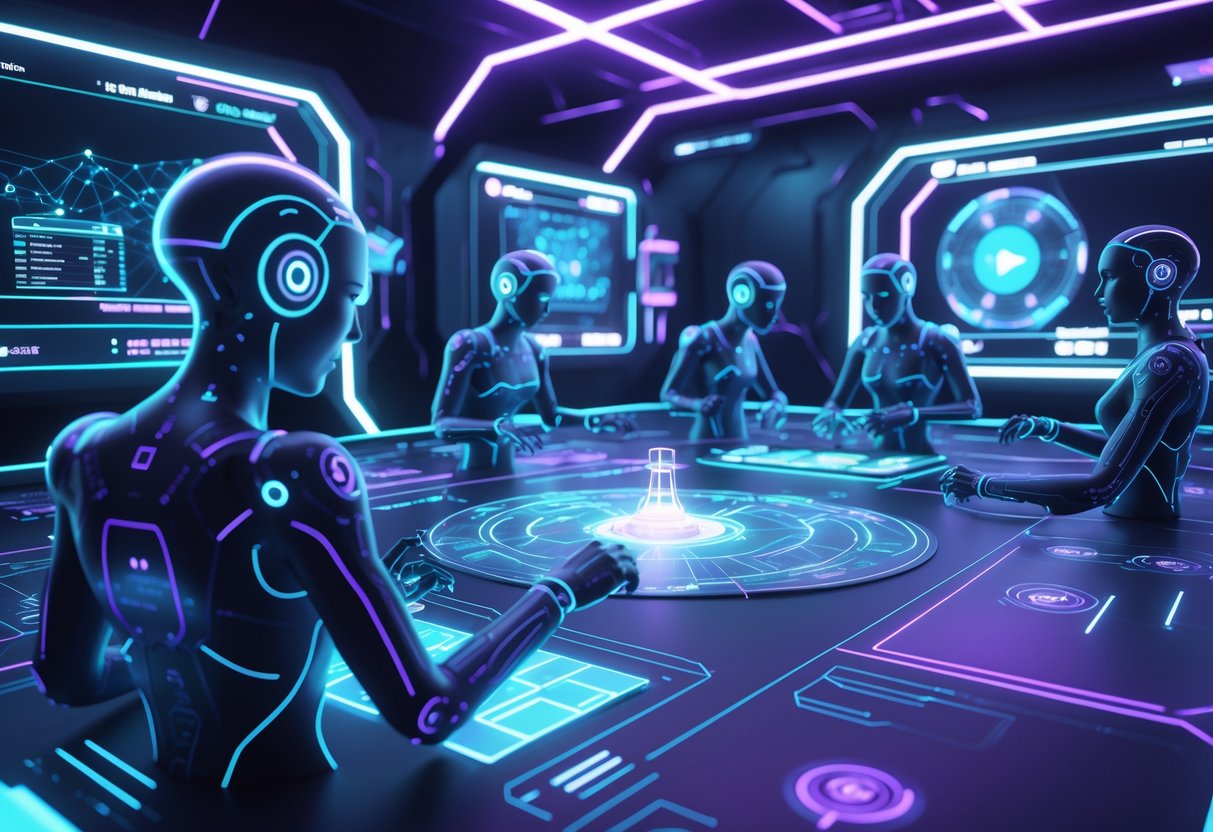
AI practice partners blend machine learning, computer vision, and natural language processing to create intelligent training companions.
These systems learn from how you play, give real-time feedback, and adapt to your skill level.
Machine Learning Algorithms in Practice Partners
Supervised learning powers most AI practice partners.
These algorithms train on huge datasets of pro gameplay footage, learning from thousands of matches to spot what works.
The AI studies how top players think and move.
It pays attention to timing, positioning, and tactical choices, building up a knowledge base of expert moves.
Reinforcement learning lets AI partners improve over time.
The system gets rewards for good coaching decisions and negative feedback when it messes up.
It’s a lot like how human coaches learn from experience.
The AI gets better at spotting your weaknesses and figures out which drills work for different skill levels.
Neural networks handle complex gaming data fast.
They analyze lots of game elements—player movements, resources, team coordination—all at once.
These networks pick up on subtle patterns you might not notice.
They spot mistakes that keep happening, so your practice gets more focused.
Computer Vision and Pattern Recognition
AI practice partners use computer vision to watch your gameplay in real time.
They track your character’s movements, what weapons you use, and where you are on the map.
This creates detailed performance analytics.
The system recognizes specific scenarios automatically.
It notices when you’re in a fight or making a big strategic move, then pops up with coaching tips that fit the moment.
Pattern recognition helps the AI figure out your play style.
Are you aggressive or defensive? Do you stick to certain weapons or tactics?
The AI uses these patterns to customize your training.
It suggests drills that suit your habits and points out where you keep slipping up.
Some advanced systems even read your emotional state from how you play.
If you start making erratic moves or bad decisions, the AI might suggest taking a break or dial down the difficulty.
Image processing helps the AI scan the game visuals.
It keeps track of enemy spots, resources, and hazards, using this info to recommend smarter strategies.
Natural Language Processing for Interaction
Natural language processing (NLP) lets you talk to your AI coach like you would a real person.
You can ask about strategies in plain English, and the AI gets what you mean.
Modern NLP systems understand gaming lingo, slang, and abbreviations.
That makes chatting with your AI partner feel natural.
Speech recognition means you can use your voice to get coaching tips while you play.
The AI responds with quick audio or text, so you don’t have to pause your game.
The system learns how you like to communicate.
Some players want detailed breakdowns, others just want a fast tip. The AI adapts to your style.
Sentiment analysis helps the AI pick up on your mood.
If you’re frustrated or confused, it can change up its coaching style to keep you motivated.
Advanced NLP gives you feedback that’s actually about your gameplay—not just generic advice.
The AI calls out your specific mistakes and helps you fix them faster.
Key Features of AI Practice Partners
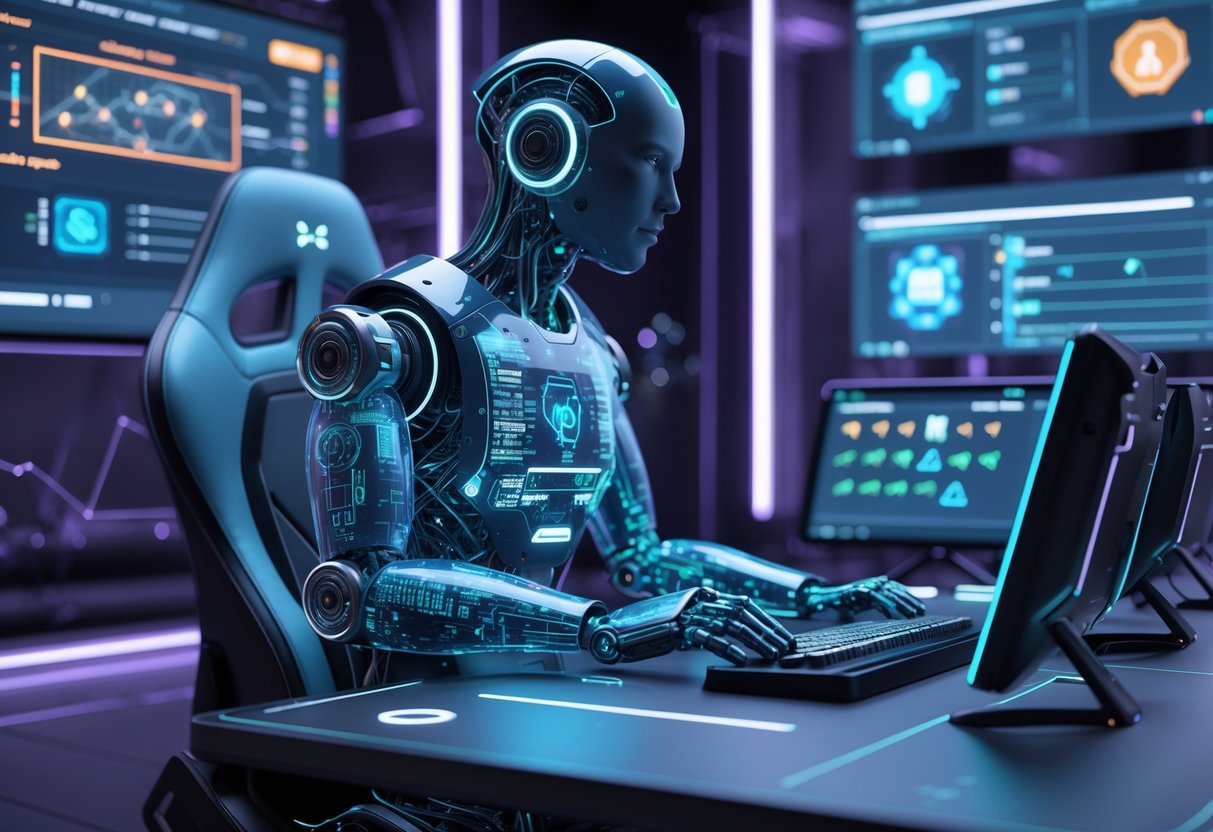
AI practice partners mix adaptive learning tech and personalized coaching to change how we get better at games.
They use real-time analysis and dynamic content delivery to create training that keeps up with your needs.
Adaptive and Dynamic Gameplay
Adaptive gameplay is at the heart of great AI practice partners.
They watch your performance and adjust the challenge level as you play.
The AI tracks your reaction speed, decisions, and strategies.
It tweaks enemy behavior, spawn rates, and scenario complexity to keep you in that sweet spot where you’re learning but not overwhelmed.
Dynamic gameplay features include:
- Enemy AI scaling to match your progress
- Scenario generation based on what you need work on
- Difficulty curves that keep things interesting
- Practice modes for specific skills
James Connolly, a gaming expert, put it well: “The best AI practice partners never let you get comfortable. They’re always pushing you, but never to the point where you want to quit.”
Modern systems juggle tons of variables at once, like movement speed or tactical complexity.
Real-Time Assistance Capabilities
Real-time assistance sets AI practice partners apart from old-school training tools.
They give you instant feedback while you play, without breaking your flow.
The AI analyzes your actions frame by frame.
It spots mistakes as you make them and offers corrections—sometimes as a quick visual cue, sometimes with a short pause-and-explain.
Key assistance features:
- Mistake highlighting with fixes
- Performance metrics on the fly
- Strategic advice at decision points
- Coaching after a failed attempt
Voice recognition lets you talk to your coach mid-game.
You can ask questions and get answers that fit the situation.
The AI learns how much info you want.
Some gamers want a deep dive, others just want a fast tip.
Personalized Content and Tailored Advice
Personalized content makes sure your practice focuses on what you actually need.
The AI sets up custom training based on your data.
Machine learning picks up patterns in your play.
It spots repeated mistakes, favorite strategies, and areas where you can grow.
Tailored advice covers all the bases:
| Area | Personalization Features |
|---|---|
| Technical Skills | Custom aim and movement drills |
| Strategy | Situational breakdowns, decision trees |
| Mental Game | Stress and focus coaching |
| Team Play | Communication tips, role advice |
The AI remembers how you learn best.
If you like visuals, you’ll get diagrams. If you learn by doing, the AI sets up practice scenarios.
Quick win: Most AI partners do a quick personality assessment early on to figure out how to coach you best.
Progress tracking keeps you motivated.
The system celebrates milestones and shifts your goals as you improve.
Benefits for Gamers
AI practice partners boost player engagement and skill growth in ways you can actually measure.
They deliver training that’s tailored to your needs and play style.
Improved Player Engagement
AI practice partners tackle one of gaming’s biggest headaches: most new players drop off after just a week.
Unlike human opponents who might be busy or just unreliable, AI companions are always there.
They act like improv partners, reacting to your choices and keeping things interesting.
Games with AI companions usually see players sticking around way longer than games with just basic bots.
Personalization is the game-changer here.
Your AI partner learns what you like and adjusts.
If you go for aggressive plays, it pushes back. If you’re new, it goes easy and doesn’t judge.
Quick win: Pick games with AI partners that remember your progress between sessions.
Enhanced Learning and Skill Development
AI practice partners make learning tricky game mechanics way less stressful.
Traditional tutorials can feel rigid and frustrating.
Smart AI systems spot your weaknesses and set up practice scenarios just for you.
If you struggle with defense in fighting games, your AI will keep creating safe spaces to practice those moves.
The learning process is smoother:
- Mistake analysis: The AI tracks errors and suggests fixes
- Difficulty scaling: Challenges get tougher as you improve
- Skill gaps: The AI finds areas you might not even realize need work
A lot of players say they improve faster with AI partners than with random online matches.
You get focused practice without the headaches of toxic or unpredictable teammates.
Custom Practice Regimens
AI practice partners set up training plans that fit your goals and your schedule.
Whether you’re prepping for a tournament or just want to win more weekend games, the AI adapts.
They track your stats and suggest when to practice.
Some folks do better in the morning, others with shorter, more frequent sessions.
Your AI partner learns these habits.
Personalized features include:
| Feature | How It Helps |
|---|---|
| Adaptive difficulty | Keeps things challenging but not overwhelming |
| Progress tracking | Shows your growth over time |
| Weakness targeting | Focuses on what needs work |
| Session planning | Finds the best practice length and timing |
The AI remembers your goals and tweaks training to match.
If you’re gearing up for a specific tournament, it’ll set up scenarios that match those rules and common strategies.
AI Practice Partners in Multiplayer Gaming
AI practice partners are changing the way players train for competitive games.
They give you reliable sparring partners any time, day or night.
Teams use these systems to practice coordination, and solo players sharpen their skills against opponents that actually react like real people.
Competitive Gaming Use Cases
If you’re looking to build solo skills, AI practice partners really change the game. You can jump straight into matches against bots that adjust to your level as you play.
No more waiting around for people to queue or dealing with toxic players while you just want to practice.
AI partners are great at keeping things challenging. Human players have off days, but AI stays consistent. That stability makes it easier to focus on specific techniques without random variables messing up your training.
Pro esports teams now use AI to break down opponent strategies. The AI learns how rivals play and can recreate their tactics for scrim practice. DeepMind’s research even shows AI picking up game mechanics just by watching how people play.
When your regular teammates aren’t online, AI steps in for off-peak training. That’s huge for keeping a steady routine, especially when consistency is everything at a high level.
This tech works across multiple game genres. Whether it’s shooters or strategy games, AI shifts its style to fit what the game demands.
Collaboration and Team Training
Working on team coordination drills gets way easier with AI partners. Teams can grind the same scenario over and over, with AI filling in for missing players.
You don’t have to wait for a full squad to work on tactical movement or practice set plays.
AI also helps teams learn communication patterns. It shows how to make proper callouts and time your comms in team games. New players pick up good habits faster when the AI models solid teamwork.
During strategic planning sessions, AI can simulate different team comps and show how things might play out. Coaches get to develop plans based on real data instead of just taking wild guesses.
AI partners give instant feedback while you train. They point out mistakes in positioning or missed chances right as they happen.
That kind of feedback speeds up learning way more than waiting for post-game analysis.
AI makes skill gap bridging a lot less painful. It can tone down its play for less experienced teammates, giving everyone a chance to build confidence before facing real players.
Intelligent NPCs and Behaviour Modelling
AI systems now let NPCs make much smarter decisions. They use advanced behaviour trees and adapt to players in ways that keep practice sessions feeling fresh.
These advances mean games can offer more realistic training partners. NPCs actually learn from what you do and create new scenarios on the fly.
Behaviour Trees and Decision-Making
Behaviour trees now power most intelligent NPCs in modern games. Think of them as flowcharts that help NPCs decide what to do next based on what’s happening in the game.
For example, a behaviour tree might tell an AI enemy to check if you’re close by. If you are, it then decides whether to attack, defend, or just run away, depending on its health and resources.
Modern behaviour trees include:
- Conditional nodes for checking game states
- Action nodes for doing stuff
- Selector nodes to pick between choices
- Sequence nodes that link actions together
The best systems mix different behaviour trees. One tree might handle combat tactics, while another manages how the NPC moves around.
Games like Call of Duty: Modern Warfare III use these systems so enemies can actually coordinate. NPCs can flank, call for backup, or switch strategies mid-fight.
Main advantages:
- Easier for devs to debug
- Simple tweaks for different personalities
- Can scale up or down for all skill levels
Adaptive NPC Training
With machine learning, NPCs now watch how you play and change up their tactics. This gives you training that feels tailored and keeps you on your toes.
Adaptive systems track things like your favorite attack angles, how fast you react, and even your most common mistakes. The AI then shifts its own play to keep you challenged.
Common adaptation methods:
| Method | How It Works | Best For |
|---|---|---|
| Reinforcement Learning | AI gets rewards for good moves | Combat training |
| Pattern Recognition | Looks at your movement data | Strategy games |
| Dynamic Difficulty | Changes challenge on the fly | Skill building |
Cyberpunk 2077 uses this by letting NPCs remember what you’ve done before and react differently each time. The system builds up a profile of your style and tweaks its responses.
Just a heads-up: If NPCs get too unpredictable or tough, it can get frustrating.
The best systems keep a balance. You want to feel challenged, but not like you’re fighting a wall.
Procedural Content Generation
Procedural systems let AI whip up new maps, scenarios, and challenges on the fly. That way, practice never gets stale.
These systems look at how you’re playing and create content that fits your needs. If you’re struggling with sniping, the AI might throw more long-range scenarios at you.
Types of generated content:
- Custom training drills
- Difficulty that ramps up or down
- Opponents that match your style
- Ever-changing environments
Modern tech can spin out thousands of unique scenarios from just a few templates. The AI moves enemies, switches up weapon spawns, and changes objectives to keep things interesting.
Red Dead Redemption 2 shows this off with NPCs that react to what’s happening and remember how you treated them. They make the world feel way more alive.
If you want endless practice, look for games with “dynamic” or “infinite” modes—those usually use procedural generation.
The smartest systems use player feedback to figure out which content actually helps you improve, not just what’s new.
Player Behaviour Analysis and Dynamic Difficulty
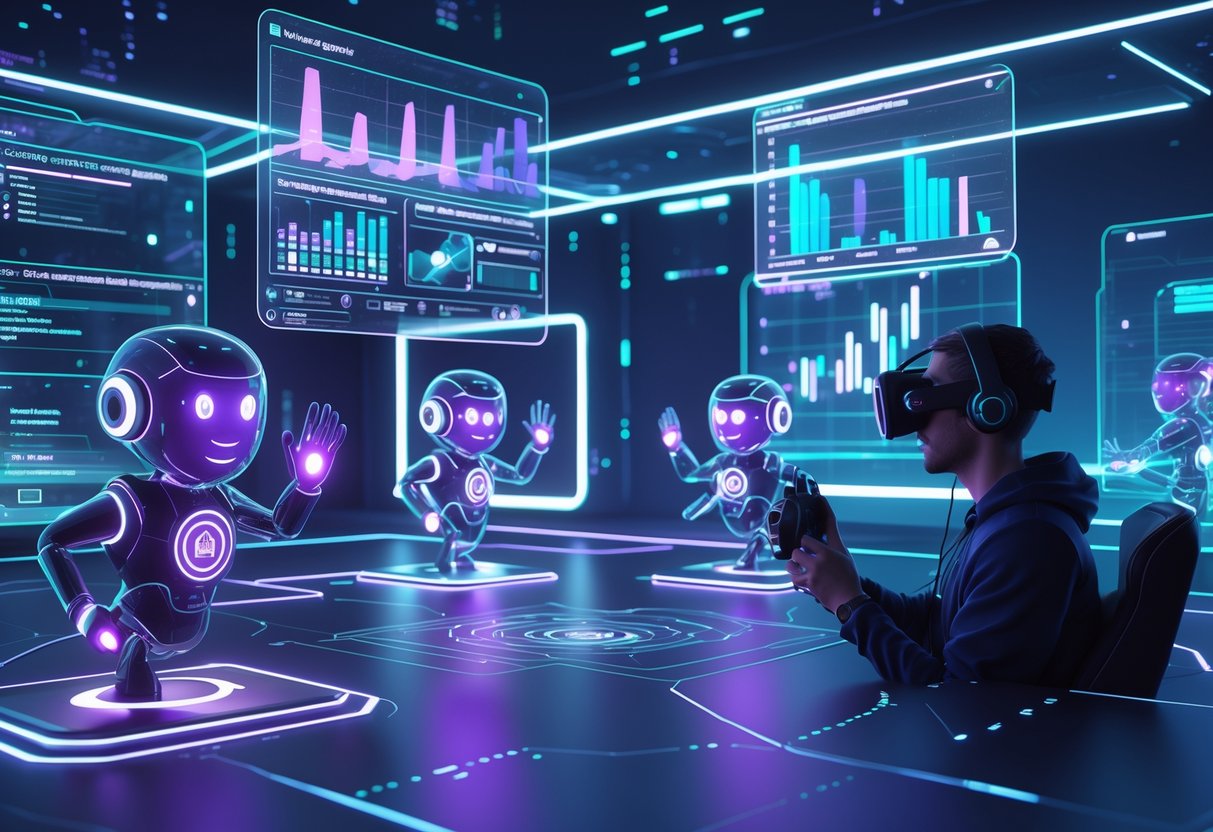
AI practice partners watch how you play and tweak the challenge level as you go. You get training sessions that match your skills and highlight where you can improve.
Tracking Skill Progression
Modern AI tracks tons of performance data while you practice. It keeps tabs on your reaction speed, aim accuracy, and how you make decisions.
Key metrics tracked:
- Average time to respond to threats
- Your accuracy percentage
- How well you manage resources
- Success rates for tactical calls
The AI builds a profile of your strengths and weak spots. It notices when your aim gets better or when you start slipping on certain mechanics. This feedback helps you get a training plan that actually fits you.
Sometimes, the AI even spots tiny improvements you’d miss. For example, it might see your aim drops off after 20 minutes and suggest a break for better performance.
Dynamic Difficulty Adjustment
The practice partner changes its skill level based on how you’re doing. If you’re crushing it, it plays smarter and gets more aggressive. If you’re struggling, it eases up a bit.
This keeps things from getting too frustrating or too easy. The AI tries to keep you in that sweet spot—the “flow state”—where you’re challenged, but not overwhelmed.
Adjustment methods:
- Tweaking reaction speed
- Changing strategic depth
- Adjusting aggression
- Varying error rates
The AI figures out your limits and keeps nudging you just past them. You get scenarios that are always a bit harder than what you’re used to, so you keep improving.
Quality Assurance and Feedback
AI practice partners give you detailed reports after each session. They point out exactly where you can get better, using real examples from your gameplay.
You’ll see video clips of moments where you made great plays—or not-so-great ones. It’s way easier to learn from visuals than just reading a list of mistakes.
Feedback usually covers:
- Tactical decisions
- Positioning and timing slip-ups
- Areas for mechanical improvement
- Patterns in your strategy
Quality assurance keeps the AI’s difficulty fair and helpful. The system stops anything that could mess up your progress, so training stays productive every time.
Innovative Use Cases for AI Practice Partners
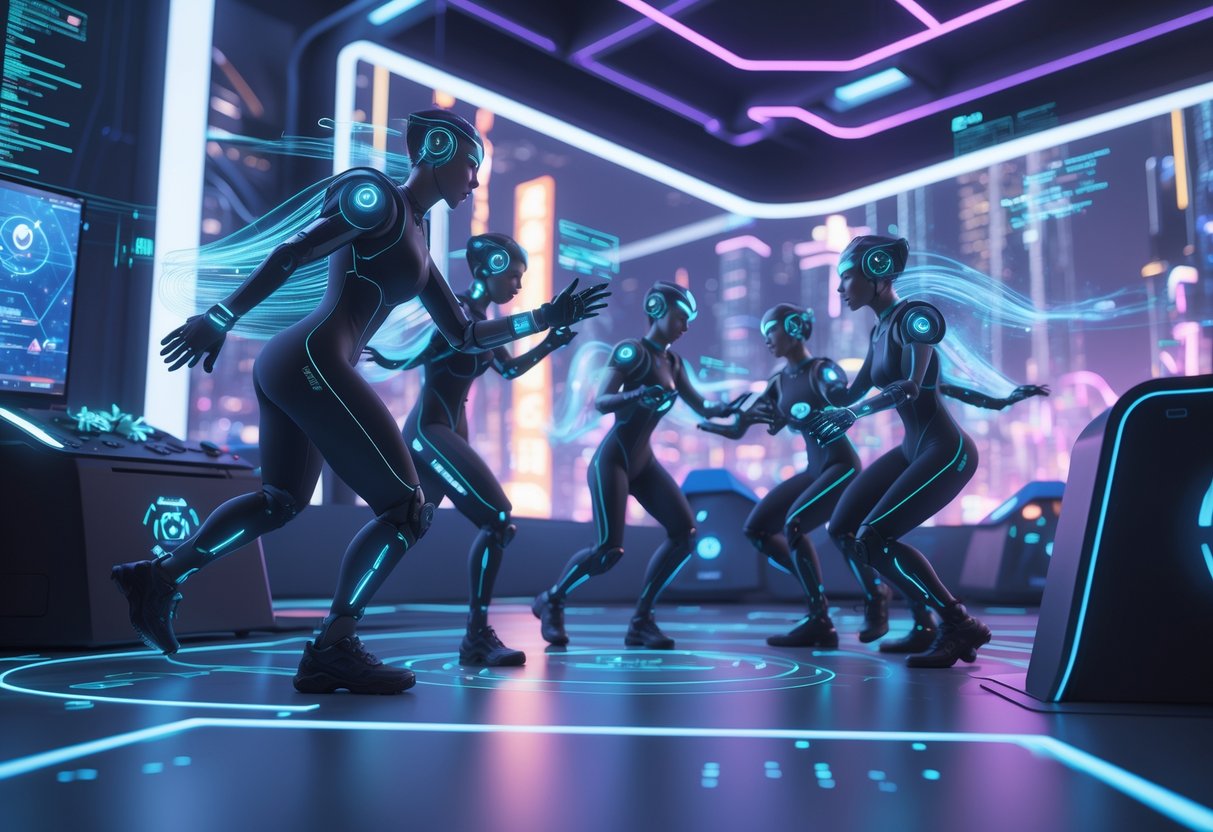
AI practice partners are shaking up how competitive gamers train. They offer coaching that’s tailored to you and build training routines that actually adapt as you get better.
Training for Esports and Pro Gamers
Pro esports teams now use AI to break down gameplay patterns and spot weaknesses. These systems track reaction times, decision speed, and strategy choices during matches.
AI integration means coaches can review thousands of hours of gameplay fast. The AI catches mistakes that even sharp-eyed coaches might miss.
Top teams use AI to build custom scenarios for practice. Players get to face AI bots that mimic real opponents’ styles. That edge can make a difference before big tournaments.
Key benefits:
- Real-time feedback
- Personalised skill plans
- Automated opponent scouting
- Custom drills for practice
Many semi-pros say their consistency goes up with AI tools. The systems help root out bad habits that sneak in over long sessions.
Personal Coaching with AI Agents
Now, even solo gamers can get AI coaching. These agents watch your gameplay and give instant feedback every time you practice.
AI coaching helps with aim, map awareness, and making better decisions. The agents keep track of your progress over weeks, so you can actually see your improvement.
Popular AI coaching platforms cost about £15-30 a month. They offer features like live voice tips during matches and post-game breakdowns.
Common coaching features:
- Live commentary
- Progress tracking
- Pinpointing weaknesses
- Practice suggestions
Most experts suggest starting with free AI tools before paying for anything. Many people see real improvement in just a couple weeks if they stick with it.
Technologies Powering AI Practice Partners
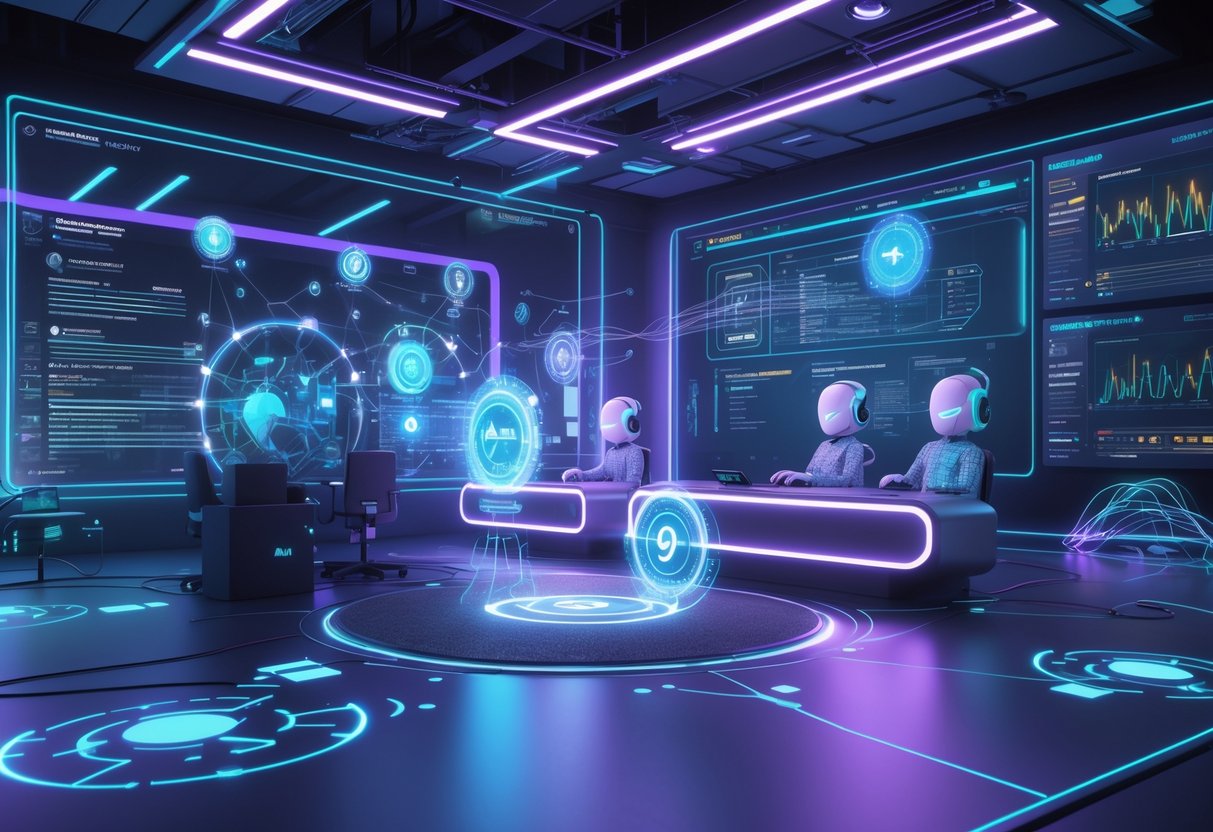
Modern AI practice partners run on powerful machine learning and plug right into existing game engines. They use reinforcement learning to adapt to you and slot into game development tools without much fuss.
Reinforcement Learning in Games
Reinforcement learning is the secret sauce for AI practice partners in gaming. This tech lets AI learn by playing millions of game scenarios and figuring out what works through trial and error.
Games like Dota 2 and StarCraft II have shown what’s possible. OpenAI Five and AlphaStar used this approach to reach pro-level skills by playing themselves over and over.
AI agents get rewards for good moves and penalties for bad ones. Over time, they build up smart strategies that actually feel human.
Main perks:
- Always improving, even without humans
- Adapts to any skill level
- Finds new strategies on its own
- Always available for practice
Modern models can handle thousands of game states every second. That means they can crunch complex situations faster than any player and stay consistent.
Integration with Existing Game Engines
AI practice partners need to fit into current game engines. Unity and Unreal Engine are the main platforms where devs add AI into games.
Most of the time, devs use APIs and middleware to hook up AI without redoing the whole game.
Common ways to add AI:
| Method | Use Case | Implementation Time |
|---|---|---|
| SDK Integration | Custom AI logic | 2-4 weeks |
| Cloud APIs | AI runs remotely | 1-2 weeks |
| Native plugins | Direct engine connection | 4-8 weeks |
Cloud platforms like AWS and Google Cloud give even small teams powerful AI tools without needing a ton of hardware.
Usually, integration means linking AI decision systems to in-game info. The AI needs to see where players are, what the objectives are, and what’s happening in the match to be useful.
AI Practice Partners for Future Gaming Experiences
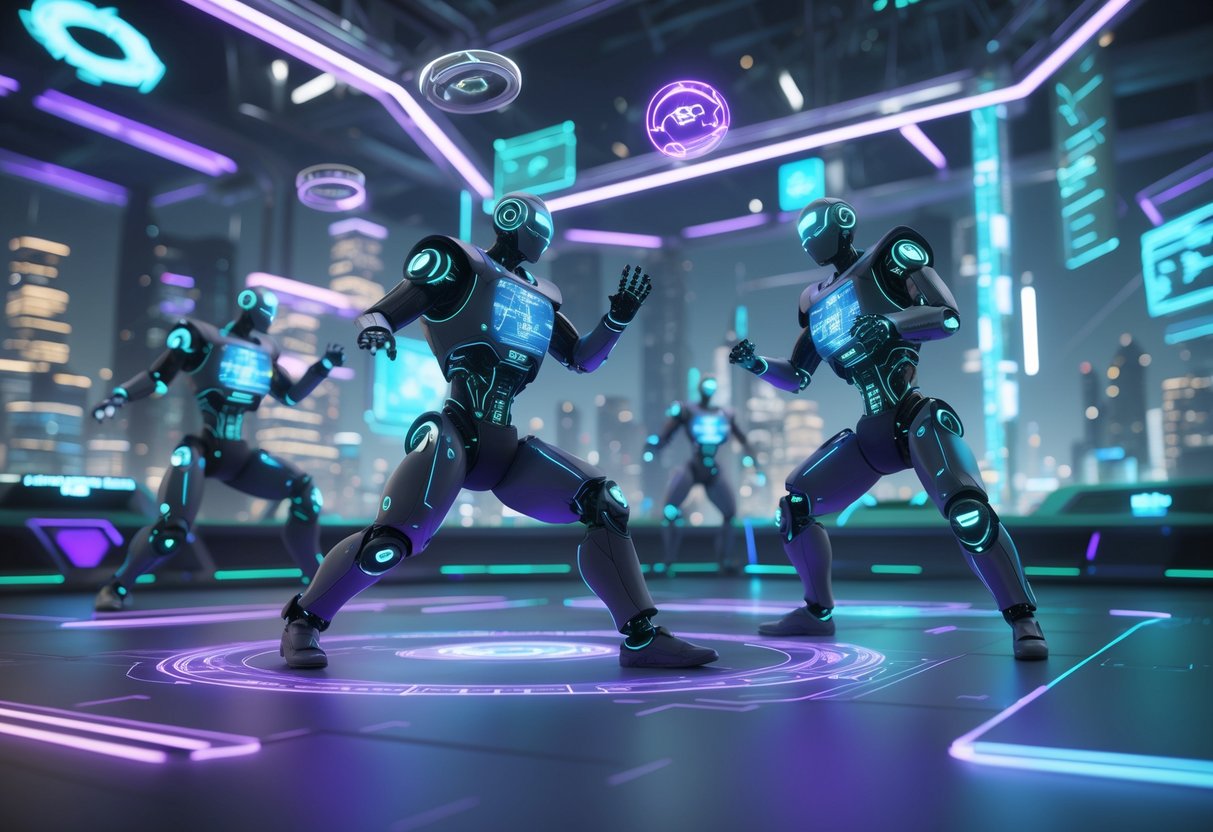
The gaming world’s moving toward experiences that feel more personal and adaptive, all thanks to AI practice partners. There’s a lot of excitement—and a few real hurdles—as these systems become part of everyday gaming.
Trends Shaping the Gaming Industry
AI applications in gaming keep pushing boundaries. Developers now go way beyond basic opponent behavior and build practice systems that actually adapt to each player.
We’re seeing Personalised Training Systems become the norm. These AI partners watch how you play, pick up on your habits, and tweak their difficulty to match your skill level.
They learn from your mistakes and set up custom scenarios to help you get better. It’s a bit like having a coach who knows exactly where you mess up.
Dynamic Storytelling is also making waves. AI practice partners can spin up new storylines based on your choices and style.
No two training sessions end up feeling quite the same, which keeps things fresh.
Tech for these systems is getting cheaper and easier to use. Smaller studios can now afford advanced AI features without needing massive budgets.
Cross-Game Learning is another cool development. AI partners can take what they’ve learned from one game and help you apply it in others.
You end up building skills that work across different genres.
Potential Challenges and Solutions
Privacy issues sit at the top of the list when it comes to AI practice partners. These systems collect a ton of player data to work well.
We really need clear rules about what data gets stored and how companies use it.
Technical Limitations still pop up. Sometimes, AI partners act in weird ways or find loopholes that people wouldn’t.
Developers are actively working on better training methods to fix these quirks.
Cost and Accessibility trip up smaller studios. Cloud-based AI services offer a solution here—studios can rent what they need instead of building everything from scratch.
This approach puts advanced AI within reach for more developers.
Player Acceptance is all over the place. Some gamers just want to play against real people.
It’s important to offer AI practice partners as an option—not as a replacement for human competition.
Quality Control is always a moving target. AI partners need regular updates to stay fair and useful.
Studios now build automated testing systems to keep an eye on AI behavior 24/7.
Privacy, Ethics, and Responsible Gaming
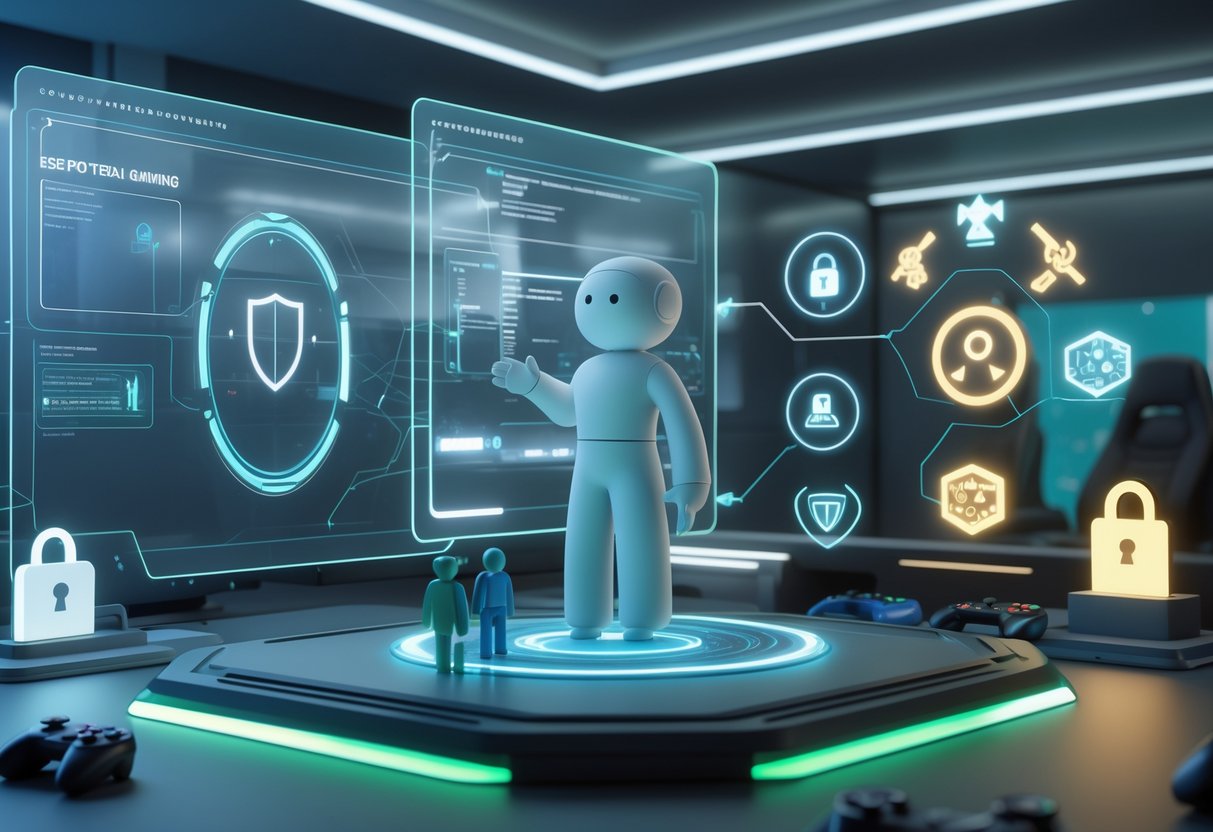
AI practice partners gather loads of real-time data about how you play. This brings up important questions—who owns this info, and does AI give some people an unfair competitive advantage?
Data Collection and Player Consent
Most AI gaming systems track your gameplay as you play. They watch your reaction times, decisions, and strategies.
What data gets collected:
- Mouse movements and keyboard inputs
- Voice commands during matches
- Win/loss patterns across different game modes
- Time spent practising specific skills
Gaming companies usually tuck data collection details into long terms of service. A lot of us just click “accept” without reading a word.
Your data rights include:
- Knowing what information gets stored
- Requesting copies of your personal data
- Deleting your gaming profile and history
- Opting out of data sharing with third parties
Some AI systems share anonymized data with researchers or advertisers. This can help improve tech, but it raises concerns about real player consent.
Try to read privacy policies before using AI practice tools. Look for companies that actually explain their data use in plain English.
Minimising Unfair Advantages
AI practice partners can widen the skill gap between players. If some gamers get premium AI training, it can make things unfair in competitive scenes.
Potential fairness issues:
- Premium AI coaches giving paying players better strategies
- Real-time analysis tools that spot opponent weaknesses instantly
- Automated aim training that exceeds human capabilities
- Pattern recognition that reveals enemy tactics too quickly
Tournament organizers have started banning certain AI-assisted tools during competitions. The line between helpful practice and outright cheating keeps shifting.
Fair use guidelines we support:
- AI tools for solo practice sessions only
- No real-time assistance during ranked matches
- Transparent disclosure when AI helps create content
- Equal access to basic training features for all skill levels
Some games now include built-in AI coaches for everyone. This helps stop expensive third-party tools from turning things into pay-to-win.
Getting Started with AI Practice Partners
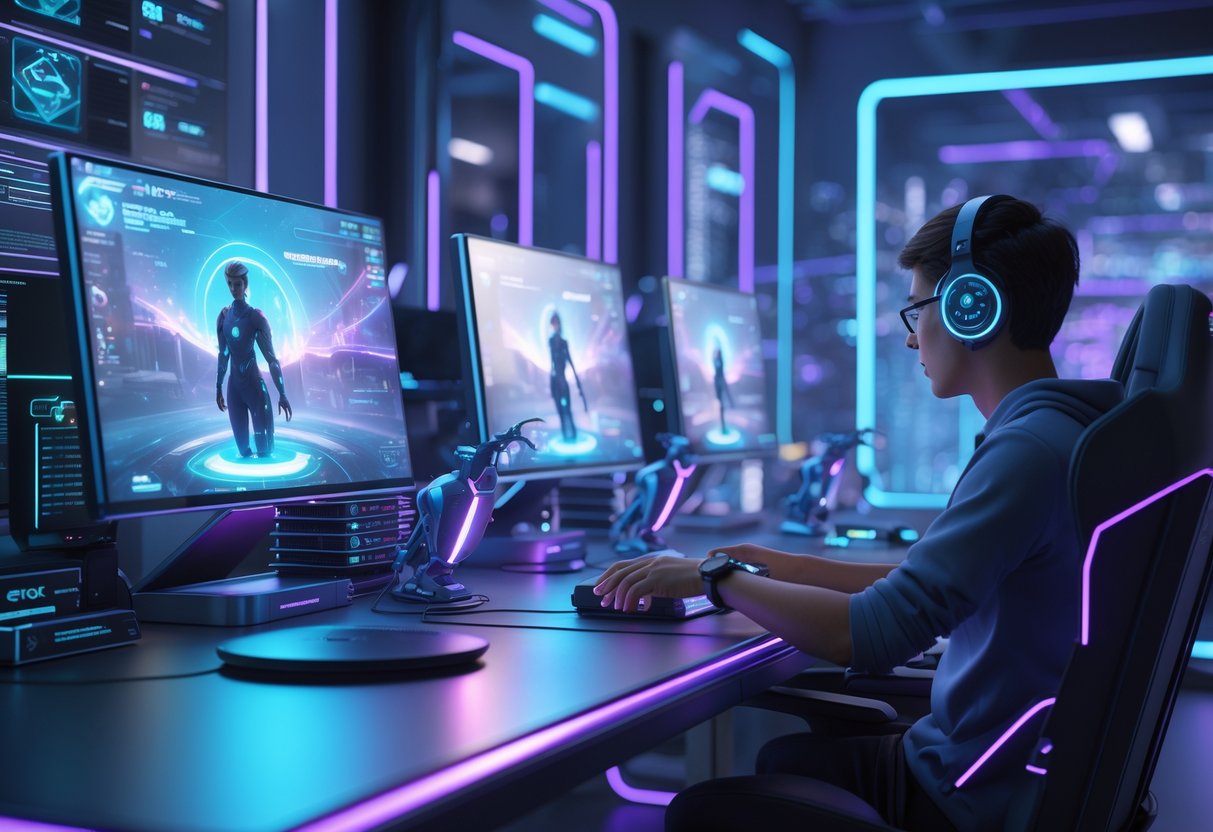
Modern AI gaming assistants can boost your gameplay with real-time coaching, strategy tips, and performance tracking. They work alongside your natural skills, spotting weak spots and offering suggestions.
Popular AI Gaming Companions and Assistants
Several AI apps have become solid practice partners for gamers. Solvyn gives you real-time strategies and personalized coaching for multiple games.
You get performance analytics that show your improvement over time.
DUOAI acts as an intelligent gaming companion. It focuses on real-time strategy and delivers insights tailored to your playstyle.
Many AI practice partners use science-backed techniques to double your knowledge retention. They push active learning and exploration over just reading guides.
These tools usually rely on natural language prompts. You can ask about strategies or get a breakdown of your last match.
Quick win: Try out free trials before you commit to any paid AI assistant.
Steps to Integrate AI Partners into Your Gameplay
Pick one AI assistant that supports your main game. Download it and go through the setup.
You’ll probably need to give some info about your preferences and skill level.
Set your preferences by choosing which parts of your gameplay you want to work on. Common choices include map awareness, timing, resource management, and team play.
Start with practice sessions instead of jumping into ranked matches. Let the AI watch and give feedback during low-stress games.
Check out the performance analytics after each session. Focus on one or two areas to improve at a time.
Warning: Don’t trust AI suggestions blindly in competitive matches until you’ve tested them out.
Carve out regular practice time each week just for working with your AI partner. Consistency trumps marathon sessions.
Frequently Asked Questions
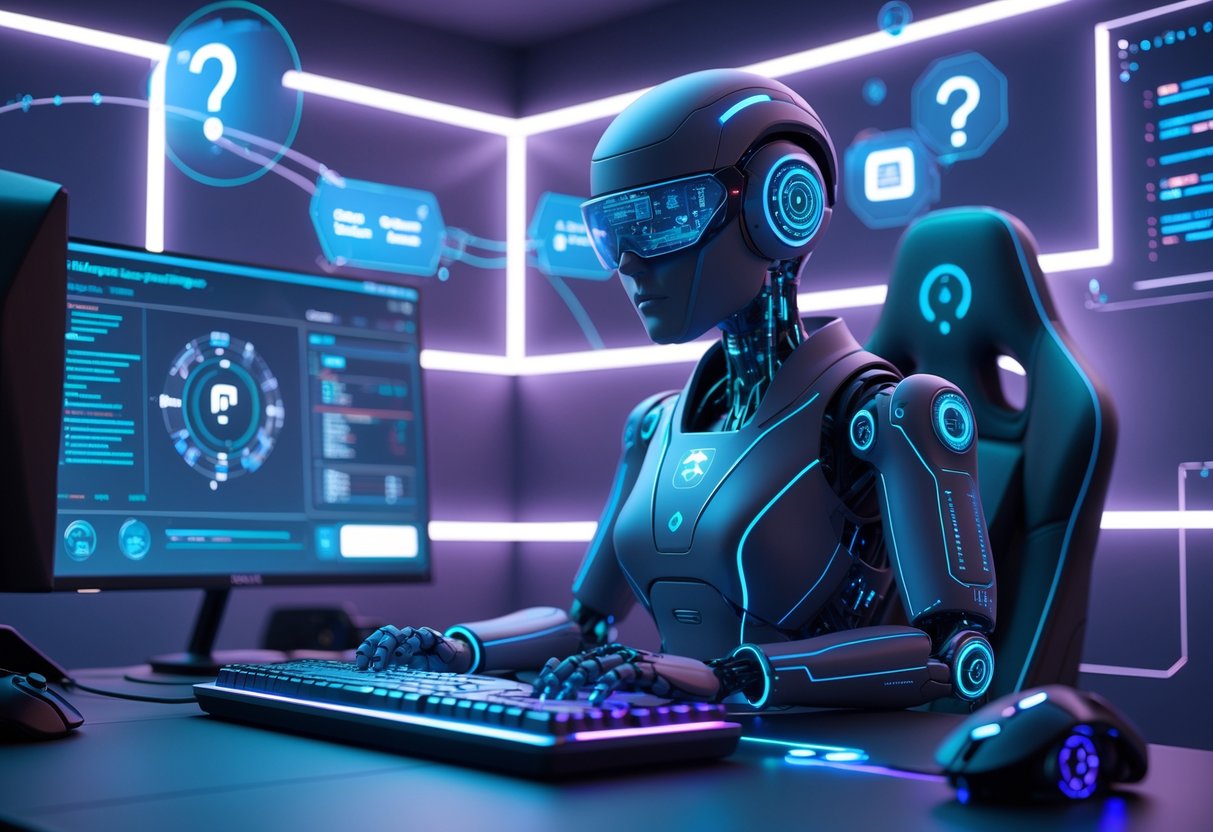
Gamers often wonder how to pick the right AI companions for practice and skill development. These AI systems can analyze your play, adapt to your style, and offer coaching that regular game features just can’t match.
What are the top virtual AI companions for enhancing my gaming experience?
Gaming Buddy stands out as a free AI-powered companion that learns your playstyle and gives personalised strategies. It recommends games, helps with multiplayer coordination, and adapts over time.
Ava from Gamerabble.ai is another good pick. It answers questions and coaches you without making you stop playing.
A lot of pro esports players use specialized AI tools built into training platforms. These track your performance and highlight areas to work on.
How can AI practice partners help me improve in competitive gaming?
AI practice partners analyze your gameplay and spot weaknesses you might overlook. They offer strategy tips, gameplay advice, and practice techniques tailored to your level.
Unlike people, AI partners are always available and can simulate endless scenarios. You can practice specific situations over and over until you nail them.
Many competitive gamers say they level up faster with AI coaching. The AI tracks your progress and automatically adjusts the training.
Could you recommend a few AI-driven games that offer engaging practice environments?
Some modern games have really impressive AI training modes now. Fighting games like Street Fighter 6 include AI opponents that adapt to your style.
Strategy games like StarCraft II let you practice with AI partners at different skill levels. The AI can focus on things like resource management or unit placement.
Battle royale games now often have AI-powered training modes, too. You can practice aim, positioning, and decision-making in a controlled setting.
Are there any AI gaming assistants that can adapt to my skill level?
Gaming Buddy uses machine learning to get to know your habits and preferences. It keeps refining its advice based on your feedback.
Professional coaching platforms usually include adaptive AI systems. These tools analyze your gameplay footage and offer suggestions that fit your skill level.
Most modern AI gaming assistants come with beginner, intermediate, and advanced modes. They automatically adjust as you improve.
What features should I look for in an AI gaming partner to benefit my practice sessions?
Real-time analysis is a must for effective AI practice partners. Look for systems that give you instant feedback during games.
Personalization features make a big difference for long-term growth. The best AI partners track your progress and tweak their coaching as you get better.
Integration with your favorite games and platforms helps, too. Pick AI partners that work with your games and don’t make setup a pain.
How do AI practice partners differ from traditional in-game NPCs?
Traditional NPCs just stick to predictable, rule-based behaviors. These patterns don’t really change.
AI practice partners, on the other hand, use machine learning. They actually adapt and tweak their strategies as you play.
Modern AI systems look at your gameplay data. They try to give you coaching that feels tailored to your style.
NPCs, though, only follow their scripts. They don’t really get what you need as a player.
AI practice partners can even break down their decisions for you. Sometimes, they’ll teach you new strategies or concepts.
Traditional NPCs? They mostly just add a bit of life to the game, but they won’t teach you much.

